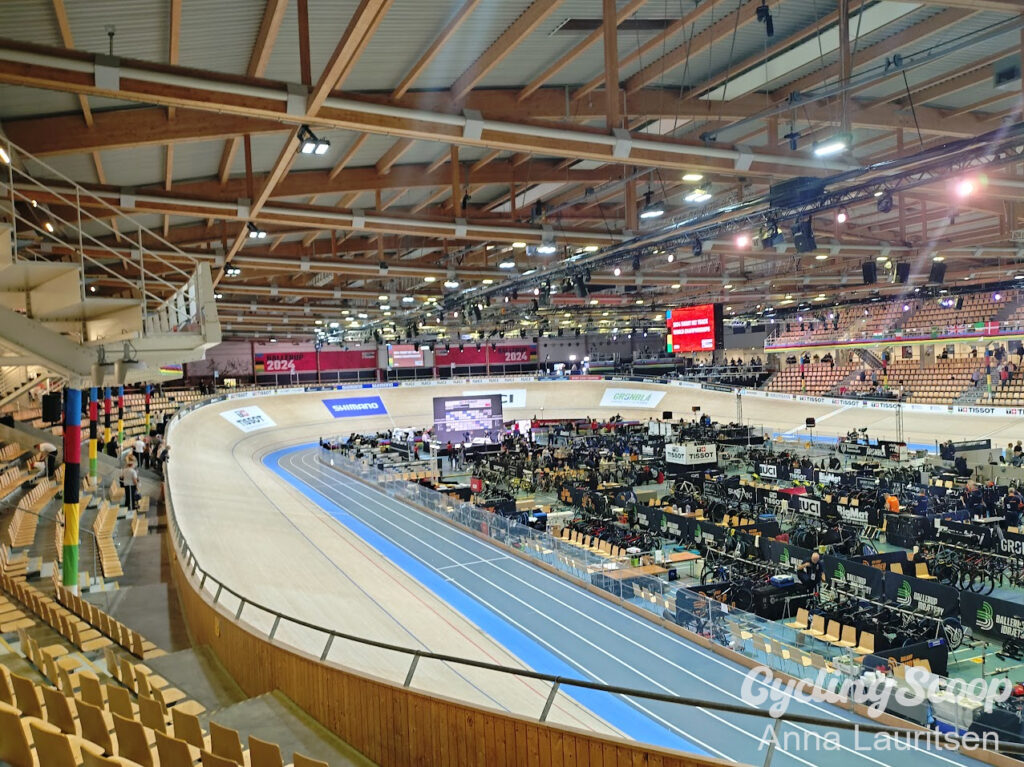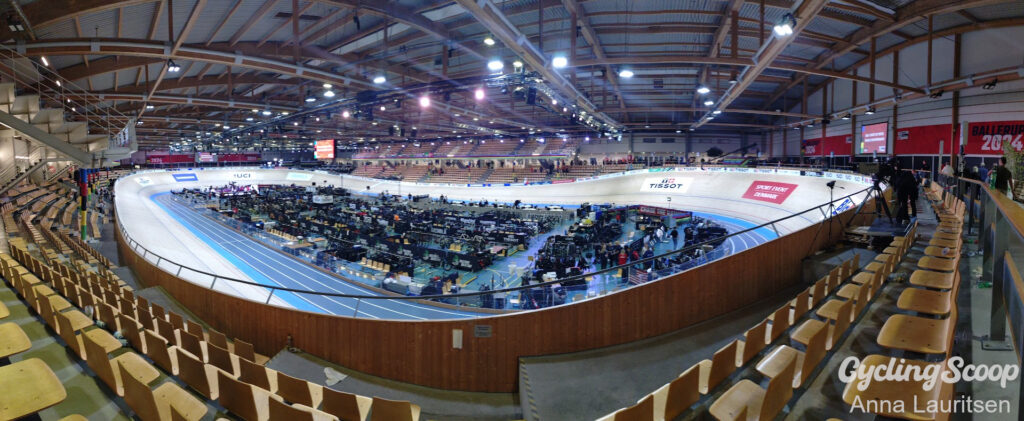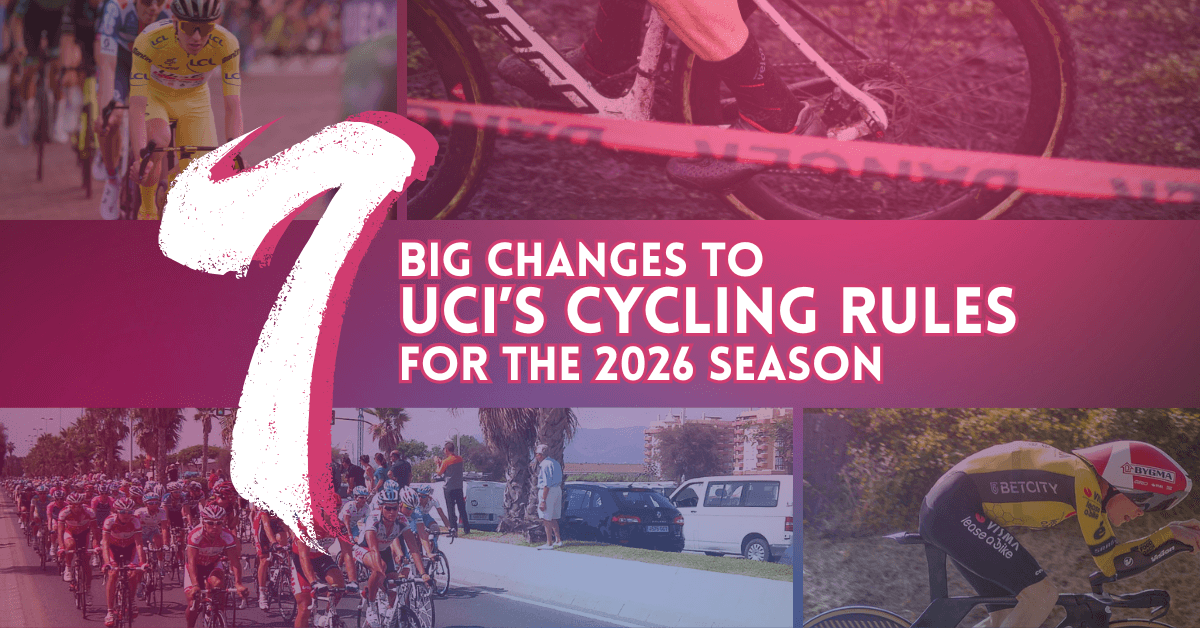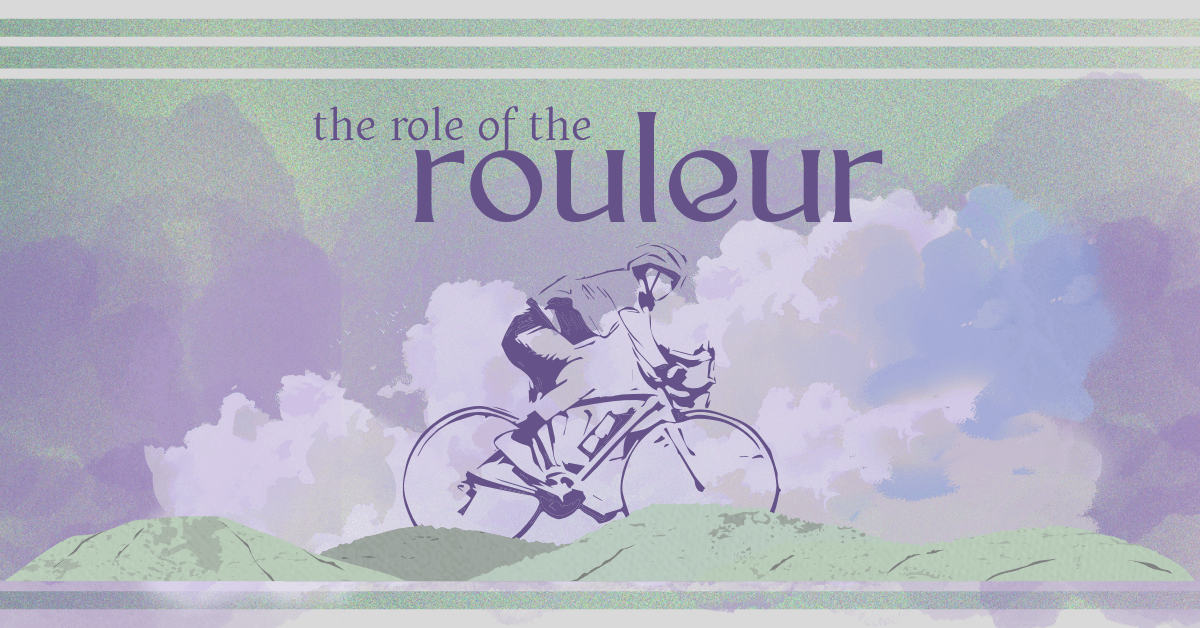For the third time, the Ballerup Super Arena just outside Copenhagen provides the backdrop for the Track World Championships. If you’re only watching on the weekend, here’s what happened on the first three days.

Photo courtesy of author Anna Lauritsen
At this time of year, the riders arrive to the venue in grey and gusty weather, an autumnal chill having settled over the Copenhagen suburb. Inside the Arena, the heat is turned up high, though that is partially to lessen the air resistance on the track. There is constant motion as athletes warm up and cool down on rollers and trainers. The sound of spinning wheels rises and falls like the sound of the wind in the trees outside, moving across the boards and around the track followed by applause.
The Danes that didn’t crack under the Team Pursuit pressure
For the vast majority of the spectators, the men’s Team Pursuit was the main event for these first three days. The Danish national team has had a major focus on this discipline, and the failure to achieve Olympic gold in Paris cast a shadow over these World Championships.
Of the Olympic team, Niklas Larsen and Frederik Rodenberg Madsen were both present in Ballerup, doubtlessly feeling the pressure Wednesday evening as the first round was held. After Japan, Germany and Great Britain each qualified for Thursday’s final, the Danes went up against Switzerland as a first step on the road to redemption. When they set off with home ground advantage and something to prove, the crowd began to roar, and the gap between the two teams grew gradually smaller until it was clear that Larsen and company didn’t just want to be the fastest – they wanted to win in the most impressive way by catching the other team. After 3000 meters, wheels overlapped and the gun sounded. The Swiss were caught, giving the Danes time for a victory lap or two. A good omen for Thursday’s final – and another bit of added pressure.
On Thursday evening, Great Britain’s team also included two members of the nation’s Olympic squad: Ethan Hayter and Charlie Tanfield. It was clear from the beginning that this match would be decided by miniscule differences instead of one team catching the other. Incremental changes would bring the Danes tenths of a second closer one lap, then further away the next for the first two kilometers. Hope, then disappointment. Cheering, then sighing.
Then, bit by bit, the gains became larger and the losses smaller until the spectators waving the Dannebrog were cheering louder each lap. The tipping point arrived as Denmark took the advantage with 2375 meters to go. In the end, it was a difference of .321 seconds that determined the outcome as the Danes crossed the line to earn gold. Looking at the riders, one gets the feeling that there would have been tears either way. This time, they were happy tears, almost hidden behind the scene used for the award ceremony.
Embed from Getty ImagesThe British and Dutch dominate the Sprints
Like with Denmark and Great Britain in the Team Pursuit, many nations have seen changes to their team rosters or priorities since the Olympics. Some of the big names who went for Olympic gold have gone home to rest up, which makes the World Track Championships an exciting event to watch for the often younger athletes take their places. An exception to this was the team for Great Britain, still identical to how it was in Paris. Katy Marchant, Emma Finucane and Sophie Capewell showed up ready to take on the Team Sprint event with their golden helmets. Racing against the Netherlands, another favorite team, their smooth teamwork and perfectly timed rotations let them achieve their stated goal of being both Olympic and world champions.
Read more: ‘I just really wanted it’ – Emma Finucane soars to sprint gold at Track World Championships
From the road to track rainbows
Wednesday also brought the Scratch Race. On paper, it could seem like the simplest discipline when the winner is whoever goes first across the line, but in reality, it’s something that requires nerve and strategy. While the peloton kept a steady pace for the first half, there were some riders who believed that they could make it ahead of the pack: Marion Borras of France slowly gained speed to escape, but was unable to keep it up past lap 25. USA’s Jennifer Valente and Spain’s Marina Garau Roca also tried with 9 and 7 laps to go respectively, watched carefully by the riders in the peloton trying to conserve energy before they were eventually caught.
One of the riders keeping back in the peloton was Lorena Wiebes from the Netherlands. A road cyclist, she has been riding for Team SD Worx – Protime in races like the Tour de France Femmes. There, she got second place in the fight for the points jersey while her teammate Demi Vollering got the second place overall – and I think it’s fair to say that Vollering’s dramatic journey through that race somewhat overshadowed Wiebes’. In Ballerup, the sprinter let herself fade into the background as well as one can when wearing bright orange, not reacting to Valenta and Roca’s attacks. She had the one of the skills a sprinter needs to succeed: The willingness to wait, keep cool, and get into position. On the last laps, she emerged from the peloton to open a long sprint. Suddenly, the power was all there for her to cross the line first. Instead of a green jersey, she has earned the right to wear the whole rainbow.
Embed from Getty ImagesThe German women claw back a surprising Team Pursuit victory; Great Britain ultimately takes gold.
Another great moment from the women’s side of the competition was in the first round of the Team Pursuit. One thing is knowing that 4000m is a long distance, another is feeling it as clearly as one could when Germany raced against Italy in the third heat. If you missed it, this could be worth a watch for the way Italy’s team led by Letizia Paternoster seemed to have the Germans absolutely cornered until the final seconds. Germany did eventually lose to the British team in the final round, but that nail-biter of a match in the first round is still worth mentioning.
A world record broken twice over
Friday afternoon, Josh Charlton of Great Britain circled the track with confidence and a posture that almost didn’t let on how hard he was working. He was gaining time on his Italian opponent Manlio Moro, but it still seemed to be just another heat in the qualifying round for the men’s Individual Pursuit. Never unsteady in the saddle, Charlton got closer and closer. Only after a while did the people surrounding him in the arena realize that he was also getting closer to beating the world record set by Filippo Ganna in 2022. Heads turned – people had been chatting and buying beer when it was announced over the loudspeaker – but Charlton himself did not seem surprised. He stepped off the bike as if he had expected it to happen.
In the final, Charlton again went up against an Italian. This time, it was Jonathan Milan, who could now pursue revenge on behalf of his nation. Earlier this year, Milan had his successes in the sprint stages of the Giro d’Italia where he made an imposing figure, being bigger than some of the smaller road cyclists and having a sprinting style that usually involves a lot of rocking back and forth like the bike is about to slide out from under him. On the track, he was something else – smooth, controlled, and smiling at the end. The world record was beaten for the second time in a few hours as Milan went under Charlton’s time by 0.151 seconds, winning gold.
Daniel Bigham had a really cool bike
After Milan and Charlton, Daniel Bigham was the last man on the Individual Pursuit podium. The race for bronze also marked the end of his career, but one can only hope it’s not the end of bright pink disc wheels on the track. His Pinarello had an asymmetric paintjob that really used the fact that it’d be seen multiple times from different angles with black on one side and fuchsia on the other. He may have gotten bronze in the Pursuit, but he won the style competition.
Embed from Getty ImagesHarrie Lavreyson was also cool
While Bigham left the track behind, Dutchman Harrie Lavreyson cemented his importance on it. By winning the 1 Kilometer TT, he achieved a record-breaking 15 World Championship titles. Not coincidentally, he could also have won a prize for being the best at getting the tight rainbow shirt on during the podium ceremony, if something like that existed. Many others struggled, but Lavreyson seemed a man in his element all evening. After his award ceremony, he stood by the bannisters chatting to his parents, his stuffed swan under his arm.
Embed from Getty ImagesThe men’s Points Race
From 4000m to 40 kilometers – Niklas Larsen had another challenge ahead of him. This is another event that might deserve a watch if you’ve got around 45 minutes, as there was barely a moment where somebody wasn’t making an effort to change up the standings.
The Points Race has a certain rhythm to it with the repeated sprints at steady intervals and the changing of the guard at the front of the peloton. At the same time, it’s also about finding that one moment where you can make an effort to gain an all-important lap on the others. The Danes were chanting Larsen’s name, hoping to see a repeat of Thursday’s gold-winning performance. From the stands, his old Madison partner and soon-to-be coach for the Nationa Team Michael Mørkøv watched nervously as Larsen accelerated. Twice, he managed to lap the peloton, but even this did not prevent the race from coming down to a single point in the final sprint.
In the end, Spain’s Sebastian Mora Verdi simply refused to fade in the last laps. He did what one has to do to win, forcing himself to go around the track just one more time, just a little faster, staying on the attack, staying in the rhythm.
Upsets during the women’s Omnium
Our final highlight is the women’s Omnium. Ally Wollaston from New Zealand performed well in the Scratch and Tempo races, winning the latter, though Danish Amalie Dideriksen was in the overall lead going into the Elimination Race. But when Dideriksen got caught in a bad position and eliminated a bit too soon, the overall standings became closer and the Points Race even more important.
The first three elements in the Omnium build up a leaderboard, and then the Points Race at the end is about seeing those standings shift and change as an ordered peloton dissolves into smaller groups and single riders trying to get a lap ahead of the others. Dideriksen made a few attempts at solo attacks, but in the last laps, it was clear to see that she had nothing left to give. Wollaston, on the other hand, slowly and surely accumulated points throughout the sprints all the way to the last lap and the gold medal. And meanwhile, something else happened in the chaos – the Norwegian rider Anita Stenberg found her way to a bronze, which deserves mention because it was one of those medals that seemed to matter as much as gold to both her and the Norwegians.
Embed from Getty ImagesAnd now…
The men’s Omnium and Keirin, the Madison races and more stuffed toy swans await on the weekend. After that, the October dark in Denmark. For some of the riders, the road bike back to their accommodations and some silence after the cheering crowd and pop music of the arena.
For us who get to watch, a lot of warmth and memories.

Photo courtesy of author Anna Lauritsen
Many thanks to Anna for bringing this event to life for us! Have you been watching the track world championships this week, and will you watch the rest? Let us know your thoughts on the action so far in the comments or via social media! ★










Leave a Reply